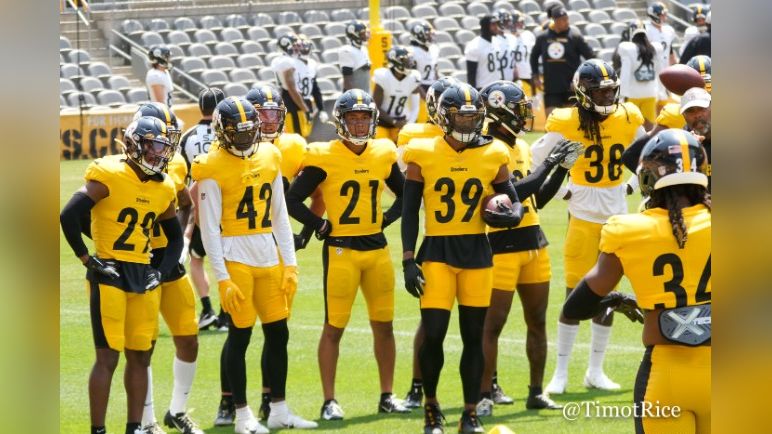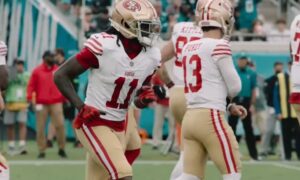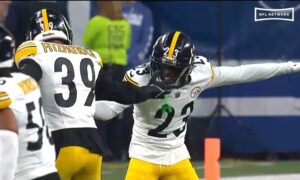Following the announcement of his retirement, Keith Butler has been making his rounds with the local media, ultimately confirming what many already knew, that being that Mike Tomlin only has a hand in the defense, but has functioned as the primary play caller recently. In fact, Butler went as far as to say that Tomlin has been calling plays not only throughout his entire tenure as the teams defensive coordinator, but even into some of Dick LeBeau’s final seasons in the organization.
First cutting his teeth as a defensive backs coach at the collegiate level before serving that position for the Super Bowl champion 2002 Buccaneers, Mike Tomlin is a far more cerebral defensive mind, specifically in designing coverages, than he often receives credit for. Largely centering his coverage philosophy around grouping together a secondary composed of high IQ players capable of communicating and executing difficult post snap rotations, which often confuse opposing passers.
Since acquiring high level talent on the back end, Mike Tomlin commanded a pass defense which for consecutive years finished top six in the league in yards per attempt, completion percentage, opponent passer rating, and interceptions in 2019 and 2020. Following some key offseason losses and a slew of notable defensive injuries which saw the Steelers pass rush, the 2021 unit posted the league’s 9th best completion percentage allowed, finished 17th in yards per attempt, 11th in opponent passer rating, 8th in passing touchdowns allowed, and 15th in interceptions. Today, we’ll be taking a look into the primary defensive calls and coverage schematics of a Mike Tomlin led defense, specifically contextualizing from this past 2021 season.
Cover 3
Any great coach should be malleable in the way he approaches his schematics on a year to year basis, infusing his preferences with what will fit best with the personnel. With that in mind, Mike Tomlin, who notably comes from a Tampa 2 background, has shifted the Steelers toward becoming more of a single high centric defense since acquiring an All-Pro post safety in Minkah Fitzpatrick early in the 2019 season. Since his acquisition, the Steelers defense under Mike Tomlin has heavily featured multiple variations of both Cover 3 and Cover 1, many of which seek to confuse quarterbacks with sound post snap rotations.
One of the notable advantages of Cover 3 is that it allows a defense to protect against the deep ball while also placing eight defenders in the box to adequately defend the run. Particularly with the Steelers personnel, featuring an All-Pro free safety with range to man the post effectively, alongside a safety who flourishes as a weak side overhang run defender in the box, this variation of Cover 3 has proven to be effective over the past three seasons.
On the rep below from the teams dramatic Week 18 victory in Baltimore, the Steelers align eight defenders, including Terrell Edmunds in the box, leaving Ahkello Witherspoon, Cameron Sutton, and Minkah Fitzpatrick to split the field into three deep ⅓ zones. Underneath, Edmunds and Outside Linebacker Alex Highsmith zip out the flats, while Devin Bush and Robert Spillane drop to their hook/curl zones, giving the Steelers four defenders underneath and three over the top on a shortened field.
The Ravens scheme the coverage well, running a deep out route with the X receiver, accompanied by a post/seam combination from the Z and Y, putting the post safety, Minkah Fitzpatrick in conflict. That being said, Cam Sutton does a great job to give an “in/under” call, passing the deep out route to Alex Highsmith and Robert Spillane, and allowing himself to sink and close toward the hashes, where he dives to undercut Tyler Huntley’s pass and secure a crucial interception. Schemes will always have exploitable weaknesses, but preaching communication and acquiring high IQ players in the secondary allows the defense to mask the coverage’s weaknesses post snap.
As I previously touched upon, the Steelers don’t often stray from their base coverages, rather choosing to rely on post snap rotations by the safety’s to disguise the coverage and force the opposing quarterback to hold onto the football and decipher the pre snap/post snap picture. One of the most common post snap rotations the team uses is deploying their safeties as a “sky” defender out of a pre snap two high shell. In a Cover 3 “sky”, zone assignments remain the same, but one safety will rotate to the deep 1/3 and assume the post safety role, where the opposite safety will “sky” down to flat or hook/curl from their two deep alignment.
This particular rotation from a two deep shell into Cover 3 can be particularly effective in forcing a quarterback to hold onto the ball, as he will be given a middle of the field open read with the twin high pre snap alignment, but will be forced to work through a middle of the field closed read post snap. On the rep below, the team aligns in a two high shell pre snap on third and long, with Minkah rolling down as the hook/curl defender and Edmunds rotating to the post, splitting the field into three deep ⅓ zones with Joe Haden and Ahkello Witherspoon. Marcus Allen and Cam Sutton buzz to their respective flat zones and Robert Spillane drops into his hook/curl near the sticks opposite of Minkah.
In third and long situations, the Steelers post snap safety rotations can be particularly dangerous and well disguised, as Minkah is able to sit with his feet planted at the sticks due to the obvious passing situation, leaving opposing quarterbacks unaware of his assignment. One of the biggest weaknesses of Cover 3 are access routes which can hit underneath the deep ⅓ cornerbacks, such as the curl slide that the Browns run into the boundary below, pulling Marcus Allen toward the sideline and opening up a window to throw the curl for a healthy gain. Witherspoon does a great job of staying patient while gaining depth in his crossover run, diagnosing that his zone is not being threatened vertically, coming to balance, and driving Mayfield’s throw, finishing at the catch point with violence for the pass breakup.
On obvious passing downs, such as the third and 14 situation that the Ravens find themselves midway through the fourth quarter of a Week 13 game, Tomlin and Teryl Austin often dial up some of their most elaborate post snap rotations. One of their most intricate, deployed situationally since 2019, is the inverted Cover 3 that we see below, in which the safety’s align in a two high shell pre snap before buzzing down into hook/curl zones, being replaced in the post by the teams Dime defender, who aligns closer to the line of scrimmage.
Here, Justin Layne, Akhello Witherspoon, and Cam Sutton split the field into three deep ⅓ zones, with Joe Schobert and Tre Norwood buzzing out as flat defenders. Due to the speed that it takes to execute the rotation in this coverage, the Steelers almost exclusively run it in obvious passing situations with their Dime personnel on the field. It is particularly effective in said situations because it allows Minkah Fitzpatrick and Terrell Edmunds to plant themselves at the sticks and force a quarterback to choose between challenging them at the sticks, avoiding the intermediate middle of the field altogether, or throwing short of the sticks.
The key to the disguise here relies on Sutton, who aligns on the line of scrimmage adjacent to Alex Highsmith before opening up into a spring post snap and working to gain depth between the hashes. One note, defensive backs at all levels are taught to not let their disguise get in the way of their assignment, as this proves to be too much ground for Sutton to cover, and likely could have been a game changing touchdown if not for a tremendous play by Ahkello Witherspoon. Witherspoon does a great job of reading Lamar’s shoulders, squeezing the seam, and high pointing the football to prevent the big play, nearly securing an interception. The Steelers have been using this invert 3 in big moments over the past three seasons, and as it relies on timing, it often works best when Sutton is able to begin his drop just before the snap, allowing him to hit his landmark earlier.
Cover 2 Man Under
After functioning predominantly as a zone team over the first few years of Mike Tomlin leading the defense, since 2019, the Steelers have sought to play man coverage at an increased frequency, particularly on key possession downs. In today’s NFL, the league’s best quarterbacks can easily maneuver through zone coverages, making it essential to have the ability to play tight man coverage and force quarterbacks to hold onto the football, allowing the pass rush to affect throws and generate turnovers.
Two man under is one of the simplest defensive calls in football, with a four man rush, both safety’s splitting the field into two deep 1/2 zones, and everyone underneath in man coverage. Different variations of the coverage could sub out one of the four down rushers in exchange for a quarterback spy or drop one of the four down linemen into a rat underneath zone, although a four man rush is most common around the league. The coverage is so effective because with safety help on both sides, defenders are able to align with heavy inside leverage and work to take away short and intermediate routes.
In the example below from Week 16 in Kansas City, Tomlin and company opt to call Cover 2 man under in the red zone, this time opting to rush just three and keep a linebacker as a quarterback spy on the elusive Patrick Mahomes. At the snap, all underneath defenders align with inside leverage, although while Joe Haden in the boundary and Cam Sutton in the slot both choose to align in press coverage, Akhello Witherspoon aligns flat footed in off coverage at six yards depth. At the snap, Witherspoon opens inside, allowing the receiver to pass him and shifting into trail technique, face guarding the receiver as he breaks on a post, and staying disciplined to close and finish through the hands on the post corner route. As is observable on this rep, Cover 2 Man Under allows the underneath defenders to undercut routes and force tough tight window throws, making it extremely difficult to throw inside the numbers.
Cover 1
When it comes to man coverage in the Steelers defensive scheme over the last three seasons, Mike Tomlin has heavily favored variations of Cover 1 far more frequently than he has deployed Cover 2 Man Under. Unlike Cover 2 man under, certain variations of Cover 1, such as Cover 1 hole, in which the post safety provides over the top help in the middle of the field, a linebacker provides middle of the field help in the hook/curl, and the remainder of defenders align in man coverage with outside leverage, allow you to put eight men in the box to protect against the run and stress pass protections.
On a third and short late in a Week 14 comeback effort against the Vikings, Tomlin and company opt to call Cover 1 hole, leaving Akhello Witherspoon and Cam Sutton in press man coverage on the boundary, Joe Schobert and Arthur Maulet in the slot, Terrell Edmunds in man coverage on the tight end, Devin Bush as the Cover 1 hole zone defender and Minkah Fitzpatrick as the post safety.
At the snap, Witherspoon matches the receivers release with patience before engaging a two hand jam to flatten the receiver’s route, stay connected to the top shoulder, and undercut the slant, taking it back 45 yards to set up another touchdown drive. With the defenders aligning in press coverage across the empty set, and eight defenders near the line of scrimmage, this variation of Cover 1 effectively shuts down the middle of the field, forcing low percentage throws downfield and outside of the numbers.
One of the Pittsburgh Steelers primary man coverage calls of the Mike Tomlin/Keith Butler era has been their Cover 1 Nickel pressure. First popularized during Mike Hilton’s tenure in Pittsburgh, in which he wreaked havoc behind the line of scrimmage unlike any defensive back not named Jamal Adams, the pressure rolls from a well disguised pre snap look rolling from a two high shell, resembling Cover 2 Man Under. At the snap, the Nickel defender, in this case Arthur Maulet, aligns in press man coverage over the slot receiver before timing the snap, and creeping off the edge as part of the five man pressure.
As Minkah Fitzpatrick drops to assume the post safety role, Terrell Edmunds rolls down into catch man coverage on the #2 receiver, while both inside linebackers are in man coverage, both cornerbacks align in off man coverage on the boundary, and the Nickel, along with the four man front form a five man rush. This call is particularly effective because coming from a two high man pre snap picture, the protection rarely accounts for a Nickel flying off the edge, leaving a quick defender with an unaltered path to the quarterback. Moreover, understanding that the five man pressure will likely force the ball out quickly, the defenders in man coverage are able to play patiently, preparing to jump short and intermediate routes.
On this rep, Arthur Maulet screams off the edge untouched, smoking Tyler Huntley as the ball is released, and nearly forcing a fumble, while Cam Sutton stays patient in his backpedal, driving to undercut a curl route intended for Reshod Bateman. Another underrated piece of this blitz, having a playmaking post safety in Minkah Fitzpatrick, throws affected by pressure and quarterback hits are often secured as turnovers.
Tampa 2
When Mike Tomlin first took over as a defensive play caller in Pittsburgh, he attempted to work his defensive roots into the system by heavily featuring the Tampa 2. The Tampa 2 is a variation of Cover 2 first popularized by the 1970s Steelers in which the two safety’s divide the field into two deep 1/2 zones, both corners man the flats, two linebackers are deployed in hook/curl zones, and the Tampa backer is tasked with covering #3 strong or #2 weak up the seam.
The coverage is particularly effective as it makes it tough to throw in the short or intermediate middle of the field, while also discouraging downfield shots down the sideline due to the deep safety’s and sinking corners which closes down windows along the sideline. Although the seams are usually a weakness of traditional Cover 2, a team with an athletic middle backer, such as the Colts Darius Leonard, and the mid 2010s Steelers with Ryan Shazier, can effectively carry the seams and force tough contested throws elsewhere.
Although no longer a primary coverage employed by Mike Tomlin’s Steelers defense, it serves as a nice changeup to their single high centric, man coverage heavy scheme. Against the Ravens, the Steelers get creative with their four man rush, sending Alex Highsmith from depth along with two down lineman and Arthur Maulet, while dropping T.J. Watt into a hook/curl zone. Devin Bush drops to the opposite hook/curl with Cam Sutton and Witherspoon in the flats, Minkah and Edmunds in the deep 1/2 zones, and Joe Schobert serving as the Tampa backer.
At the snap, Witherspoon opens from a square stance into a side shuffle, settling at 13 yard depth and reading Lamar Jackson before transitioning into a faceguard, and breaking downhill to contest the scramble drill throw. Note how this coverage takes away the shallow and intermediate middle of the field, forcing Lamar Jackson to go through all of his reads before making a contested throw outside of the numbers. The key to effectively playing the Tampa 2 is for all of the underneath defenders to gain proper depth and rally hard to the football on checkdowns.
Overall Evaluation
While Mike Tomlin’s Steelers defense runs a variety of other coverage schemes, namely Cover 4 quarters, Cover 6, Cover 3 “hot” blitzes, and the occasional zero pressure, today’s focus was intended to cover the major staples of the defensive scheme. Overall, I’d contend that Tomlin does a good job of stressing communication, post snap disguise, and discipline in his back seven, thus, it’s not exactly surprising that the unit has improved mightily since adding better players in the secondary.
Particularly later this season, when the Steelers defense was playing it’s best football, helping the team finish 4-2 down the stretch, Tomlin began to lean back on a man coverage heavy approach, simplifying coverage and allowing him to put more bodies in the box to aid the unit’s struggling run defense. Ultimately, while the Steelers need to make a concerted effort at reloading the inside linebacker and defensive line positions through the draft and free agency, it is hard to imagine this unit does not improve next season if they are able to stay healthier.
Particularly on the back end, if the Steelers are able to secure someone they consider a true #1 cornerback who can man the boundary, potentially a re-signing of Ahkello Witherspoon, they could work on adding some split field coverages, and rolling coverage away from that cornerback to defend trips sets. Regardless, beyond the notable “players coach” label attached to Mike Tomlin, a positive in its own right, Mike Tomlin is a well respected defensive mind, particularly in his work in designing coverage schemes, and deserves respect for his pass defenses productivity over the past three seasons.








